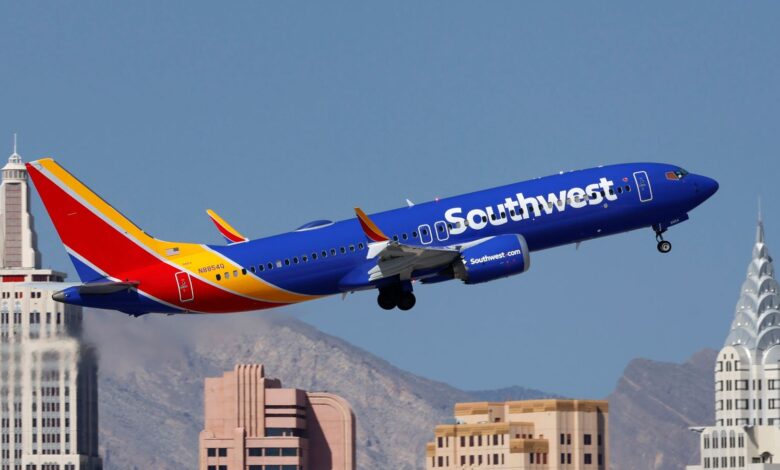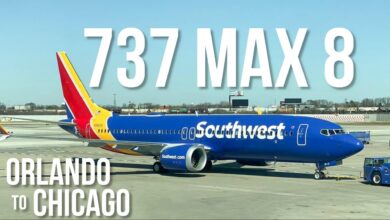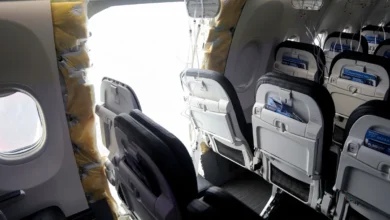Southwest Airlines Boeing 737 Max: A Comprehensive Overview

Introduction to the Southwest Airlines Boeing 737 Max
The Southwest Airlines Boeing 737 Max represents a significant advancement in the airline’s fleet, epitomizing a modern approach to air travel that enhances operational efficiency and customer experience. Developed by Boeing, this aircraft model brings with it a suite of technological innovations designed to facilitate lower fuel consumption, reduced emissions, and improved overall performance while providing passengers with greater comfort. The introduction of the 737 Max into Southwest’s fleet marks a pivotal moment, aligning with the airline’s commitment to modernize its operations amidst changing industry standards.
As the aviation industry continually seeks improvements in sustainability and efficiency, the Boeing 737 Max emerges as a response to these demands. Following its launch, the model quickly caught the attention of airlines globally, including Southwest, due to its advanced engines and aerodynamic structure, which contribute to its operational advantages. Within Southwest, the 737 Max plays a vital role in optimizing flight schedules and routes, allowing the airline to maintain its competitive edge in an increasingly crowded market.
Moreover, the integration of the Boeing 737 Max into Southwest’s operations underscores the airline’s commitment to offering a superior flying experience. With a focus on passenger comfort and satisfaction, the 737 Max model features spacious interiors and a cabin design that encourages a relaxed atmosphere. Additionally, the adaptability of the aircraft makes it well-suited for various domestic and international routes, reaffirming Southwest’s reputation for versatility and customer-oriented service.
In summary, the introduction of the Southwest Airlines Boeing 737 Max heralds a new era in the airline’s operational capabilities and customer experience, setting the stage for future developments in aviation technology and airline strategy.
Design and Features of the Boeing 737 Max
The Boeing 737 Max represents a significant evolution in aircraft design and engineering, specifically tailored to meet the demands of modern air travel. One of the standout features of this aircraft is its unique aerodynamic design, which has been optimized for improved fuel efficiency. This is achieved through the incorporation of advanced wing designs, including the distinctive winglets that enhance lift and reduce drag during flight, contributing to the overall performance enhancements of the southwest airlines boeing 737 max.
The fuel efficiency improvements are particularly noteworthy, as the aircraft is equipped with the LEAP-1B engines, which are designed to use up to 14% less fuel compared to its predecessor, the Boeing 737 Next Generation series. These new engines not only help lower operating costs for airlines but also contribute to reduced carbon emissions, aligning with the aviation industry’s shift towards more sustainable practices. As airlines continue to face pressure to minimize their environmental impact, the southwest airlines boeing 737 max provides a viable option.
Passenger capacity and comfort are integral to the Boeing 737 Max’s design. The configuration allows for seating arrangements that can accommodate various passenger loads, with options for up to 210 seats in a high-density layout. Additionally, the aircraft’s spacious cabin is enhanced by improved overhead storage and larger windows, which create a more pleasant atmosphere for passengers. Technological advancements in the aircraft’s infotainment systems further bolster the passenger experience, providing streamlined connectivity and in-flight entertainment options.
Moreover, the Boeing 737 Max integrates state-of-the-art avionics systems that enhance operational safety and efficiency. These advanced technologies facilitate improved navigation and flight management, ensuring that pilots have the essential tools needed for optimal performance. Overall, the combination of innovative design features and advanced technologies positions the southwest airlines boeing 737 max as a leading choice for airlines aiming to balance performance, efficiency, and passenger satisfaction.
Southwest Airlines Fleet Strategy and the Role of 737 Max
Southwest Airlines has long been recognized for its commitment to operational efficiency and cost-effectiveness, primarily due to its extensive utilization of the Boeing 737 series. This single-aircraft family strategy allows the airline to streamline its operations, reduce training costs for pilots and crew, and enhance overall maintenance processes. In this context, the incorporation of the Boeing 737 Max represents a strategic evolution, amplifying the advantages inherent in the airline’s fleet management structure.
The decision to integrate the 737 Max into its fleet aligns closely with Southwest’s long-established philosophy of offering low fares while maintaining a consistent and reliable service. The Max variant, with its improved fuel efficiency and enhanced range, enables Southwest to explore new market routes and optimize existing ones. These enhancements are crucial in a competitive industry landscape, as they position the airline to take advantage of cost savings that can be passed directly to customers through lower ticket prices.
Furthermore, the operational efficiencies gained from the 737 Max contribute significantly to Southwest’s ability to maintain its low-cost business model. The aircraft’s advanced aerodynamics and upgraded engines lead to reduced fuel consumption compared to previous models, thereby minimizing one of the largest operating expenses. This not only supports profitability but also strengthens the company’s environmental commitments by lowering carbon emissions per seat-mile.
In assessing the implications of the Boeing 737 Max within Southwest Airlines’ overall fleet strategy, it becomes evident that this aircraft is not merely a replacement but a vital component in enhancing the airline’s competitive edge. It facilitates the expansion of service offerings while ensuring that operational integrity and cost efficiency remain at the forefront of Southwest’s objectives. With ongoing adjustments and refinements to their fleet, the airline continues to embrace the fundamental values that have driven its success in the aviation industry.
Customer Experience on the Boeing 737 Max
Passenger experience on the Southwest Airlines Boeing 737 Max has been a significant focus for the airline, particularly in light of the aircraft’s advanced features and modern design. The Boeing 737 Max boasts a contemporary cabin layout, which enhances the overall travel experience. This aircraft typically offers a single-class configuration that accommodates up to 175 passengers, ensuring ample space for both leisure and business travelers. The seating arrangement is designed to maximize comfort while remaining budget-friendly.
The seats on the Boeing 737 Max feature a 30-31 inch pitch in economy class, which is competitive compared to other single-aisle aircraft in its category. Although some may find the legroom to be limited, the overall design of the seats provides decent comfort for short to medium-haul flights. The cabin is equipped with larger overhead bins that allow for more space for carry-on luggage, thus enhancing the convenience for passengers boarding and deplaning.
In-flight entertainment options on the Southwest Airlines Boeing 737 Max are tailored to today’s tech-savvy travelers. The aircraft does not feature traditional seatback screens; however, passengers can access a wide selection of movies, TV shows, and music on their personal devices via the airline’s Wi-Fi service. This flexibility enables travelers to enjoy their preferred content while onboard. Feedback from passengers indicates a general appreciation for the quality and variety of entertainment provided, although some customers express a desire for complimentary access to the Wi-Fi service.
When compared to other aircraft in the Southwest fleet, the Boeing 737 Max is praised for its smooth ride and noise reduction capabilities due to the new LEAP-1B engines. Passengers often comment positively on how these features contribute to an overall pleasant flying experience. Many find that the combination of advanced technology and customer-oriented design sets the Boeing 737 Max apart, creating a favorable perception of Southwest Airlines among its passengers.
Safety and Regulatory Developments involving the Boeing 737 Max
The safety of the Boeing 737 Max has been a focal point for both the airline industry and regulatory authorities since the aircraft’s initial deployment. Following two tragic accidents involving the 737 Max, which raised serious concerns about its flight control systems, the global aviation community responded swiftly. Southwest Airlines, as one of the largest operators of the aircraft, faced scrutiny and had to navigate a complex landscape of regulatory compliance and safety assurance. The grounding of the Boeing 737 Max fleet in March 2019 highlighted these issues, prompting a review and overhaul of safety protocols.
Boeing has implemented several measures aimed at addressing the deficiencies in the 737 Max’s systems. These include comprehensive software updates, specifically targeting the Maneuvering Characteristics Augmentation System (MCAS), which was implicated in both accidents. The modifications are designed to ensure a more robust mechanism for controlling the aircraft’s pitch and enhancing overall safety during operation. Additionally, the Federal Aviation Administration (FAA) and other international aviation regulators have established a more rigorous oversight and approval process to ensure that any changes made to the Boeing 737 Max meet stringent safety standards.
Alongside these technological updates, training for pilots and crew members has been markedly enhanced. Southwest Airlines has invested significantly in training programs to ensure that their pilots are well-acquainted with the updated systems of the 737 Max. This comprehensive training encompasses simulator sessions and theoretical instruction on the aircraft’s systems and emergency procedures, thereby fostering a heightened state of preparedness among flight crews. Furthermore, Southwest remains committed to maintaining ongoing communication with regulators and the public to bolster trust and transparency.
In conclusion, the developments surrounding the safety and regulatory measures of the Boeing 737 Max signify a concerted effort by both Boeing and Southwest Airlines to address past concerns. The enhanced systems, comprehensive pilot training, and adherence to updated regulations collectively aim to ensure that the 737 Max operates safely in the skies, prioritizing passenger well-being above all else.
Environmental Impact of the Southwest Airlines Boeing 737 Max
The introduction of the Boeing 737 Max series has brought forth significant advancements in aviation technology, particularly concerning environmental sustainability. One key aspect is the enhanced fuel efficiency that this aircraft offers. Compared to its predecessor models, the Boeing 737 Max is designed with advanced engines and aerodynamic improvements, enabling it to consume approximately 14% less fuel. This reduction in fuel consumption is vital for airlines like Southwest Airlines as it directly correlates with the amount of carbon emissions produced during flights.
As airlines globally strive to meet increasingly stringent environmental regulations, the Boeing 737 Max stands out as a vehicle capable of reducing carbon output. With a more efficient fuel burn, the aircraft is estimated to release fewer emissions per seat-mile. This not only benefits Southwest Airlines in their operations but also aligns with the broader goal of achieving global climate commitments. By utilizing the 737 Max fleet, Southwest can contribute to reducing its overall carbon footprint, assisting the airline in meeting both governmental and voluntary sustainability targets.
In addition to operational efficiency, Southwest Airlines has taken proactive measures to incorporate sustainable practices into its overall business model. The airlines’ commitment to reducing greenhouse gas emissions is exemplified by its strategic decision to expand its fleet with the Boeing 737 Max. Moreover, initiatives such as optimizing flight paths, implementing advanced operational techniques, and investing in sustainable fuel options further demonstrate the airline’s dedication to eco-friendly practices. Such efforts are essential in establishing a greener aviation industry, thus making the 737 Max not just a technological advancement but also a key player in promoting environmental responsibility.
Challenges Faced by Southwest Airlines with the Boeing 737 Max
The introduction of the Boeing 737 Max into Southwest Airlines’ fleet has not been without its difficulties. One of the primary challenges has been operational issues stemming from the aircraft’s design and the controversies surrounding its safety record. Following two tragic crashes involving the 737 Max, many airline operators, including Southwest, faced significant operational disruptions. The U.S. Federal Aviation Administration (FAA) grounded the aircraft for an extended period, which severely impacted Southwest’s scheduled flights and overall operations.
Public perception has been another significant hurdle for Southwest Airlines. The grounded status of the Boeing 737 Max led to a widespread perception of safety concerns surrounding the model. Although rigorous safety assessments have since cleared the aircraft for operation, achieving passenger confidence remains a monumental task. Additionally, Southwest’s customer experience was affected, with many travelers opting for alternative airlines that did not utilize the troubled aircraft, further straining their market position.
Financially, the implications of the 737 Max groundings were profound. There were substantial losses due to cancellations and compensations owed to affected customers. Southwest Airlines has to allocate significant resources to address these financial strains while also managing the nuances of returning the Max to service. In response to these challenges, the airline has implemented several strategies to reassure travelers. For instance, providing transparent communication regarding safety measures and continually highlighting the enhancements made to the aircraft have been central to their approach.
Southwest Airlines recognizes the need to regain passenger trust and has initiated marketing campaigns aimed at reassuring travelers about the safety and reliability of the Boeing 737 Max. By prioritizing customer support and integrating feedback into their service model, Southwest aims to emerge from these challenges with strengthened operational practices and a more resilient brand image.
Future Outlook for Southwest Airlines and the Boeing 737 Max
The future of Southwest Airlines and its utilization of the Boeing 737 Max model promises to shape the airline’s operational strategies and overall market positioning in significant ways. With the recovery of the aviation industry post-pandemic, Southwest Airlines is expected to leverage the advanced capabilities of the Boeing 737 Max as it aims to enhance its competitive edge. The model, known for its improved fuel efficiency and increased range, aligns well with the airline’s goals of optimizing operational costs while expanding its service offerings.
As the travel demand continues to evolve, Southwest Airlines anticipates integrating a greater number of Boeing 737 Max aircraft into its fleet, enabling the airline to serve new and emerging markets effectively. The aircraft’s modern technology, including quieter engines and updated safety features, positions it as a favorable choice amid rising passenger expectations for comfort and reliability. This strategic incorporation of the Max is expected to facilitate routes that may have been economically unfeasible before, concurrently promoting the growth objectives of the airline.
Moreover, the context of fleet renewal and sustainability has become increasingly important in the aviation sector. The Boeing 737 Max, with its eco-friendly attributes, complements Southwest Airlines’ commitment to reducing its carbon footprint. In the coming years, the alignment of such practices with fleet modernization plans is likely to resonate positively with environmentally conscious travelers, thereby enhancing customer loyalty and brand reputation.
In addition, the airline’s continued focus on competitive positioning will necessitate smart investments in technology and fleet enhancements. The integration of the Boeing 737 Max into Southwest’s operations not only supports anticipated market trends but also serves as a fundamental pillar in the airline’s strategy to navigate future challenges, ensuring it remains a key player in the industry.
Conclusion
The integration of the Boeing 737 Max into Southwest Airlines’ fleet represents a pivotal enhancement in both operational efficiency and customer experience. This aircraft model is specifically designed to meet the airline’s commitment to cost-effective travel while simultaneously elevating service quality. With its modern design and fuel-efficient engines, the Southwest Airlines Boeing 737 Max supports the airline’s sustainability goals by significantly reducing carbon emissions per flight. This operational advantage not only helps in maintaining competitive fare pricing but also aligns seamlessly with growing environmental concerns among travelers.
Moreover, the Boeing 737 Max enhances reliability and reduces maintenance costs compared to older aircraft. These improvements contribute to an overall increase in aircraft availability, enabling Southwest Airlines to offer more frequent services on key routes. Passengers benefit from reduced delays and disruptions, which plays a critical role in cultivating customer loyalty and satisfaction. By harnessing the capabilities of the Boeing 737 Max, Southwest Airlines is able to maintain its reputation for reliable air travel, which is particularly crucial in today’s competitive airline industry.
Furthermore, the Boeing 737 Max fits well within the strategic framework of Southwest Airlines, allowing the company to maintain a lean operational model while expanding its route offerings. As the airline seeks to enhance its footprint in both existing and new markets, the efficiency and performance characteristics of the 737 Max facilitate this growth. In conclusion, the Boeing 737 Max is not merely an aircraft; it is a cornerstone of Southwest Airlines’ strategy in achieving operational excellence and sustaining customer satisfaction in an evolving airline landscape.
You May Also Read This Usaworldtoday.

